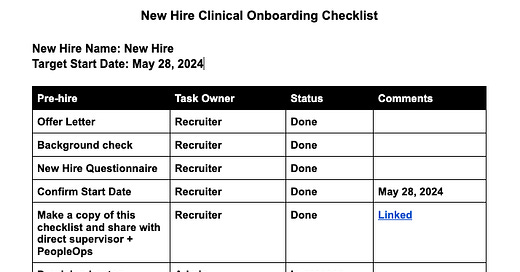Tech Recipe: Mastering New Hire Onboarding
Background:
Effective onboarding is crucial for integrating new hires into your team, ensuring they feel welcomed, informed, and ready to contribute. The cornerstone of successful onboarding is a well-defined, dynamic checklist that evolves with your business needs. This checklist should include all necessary tools, services, resources, and contacts. It must also cover legal and mandatory training requirements. Ensuring auditability by involving managers or supervisors in the process adds a layer of accountability. Whether your workforce is distributed or centralized, a comprehensive onboarding checklist is essential for a smooth transition.
Shopping List:
1. Documentation Tools:
Google Sheets or Microsoft Excel: For creating and sharing the onboarding checklist in a structured format.
Google Docs or Microsoft Word: To provide detailed instructions and resources.
For a much more structured, well defined approach you could consider building out your onboarding process in Asana or Trello. These work management tools allow you to document steps, link directly to the relevant tools and if your software integrates with Asana or Trello, you can set it up to automatically track progress.
2. Training Platforms:
Trainual: Really straightforward for creating and managing training modules.
easyLlama: Has more solutions for legal and HR compliance training.
TalentLMS: More comprehensive end-to-end learning management.
3. Communication Tools:
These tools are optional, but so useful if you can add them. Especially for distributed teams. Many training tools (and other tools) integrate with these communication tools. In the case of the training tools, as we’ll show in the recipe, trainees and supervisors can automatically get updates when various sections of training are complete, or overdue, or new training is available.
Slack: For ongoing communication and updates.
Microsoft Teams: For communication, especially if integrated with Microsoft tools.
4. Survey Tools:
If you are like us and have an HR tool like Lattice for People Management these tools have some survey functionality built in. If you need a standalone survey tool, you’re in luck.
Google Forms: For gathering feedback on the onboarding process.
SurveyMonkey: Another tool for collecting feedback.
What survey tools do you use?
Cooking Instructions:
1. Develop the Onboarding Checklist:
Task: Create a comprehensive list of tasks, resources, and training modules for new hires.
These should be clear, detailed instructions on what the task is and what success looks like. Include resources such as links and who to contact in case of questions or issues.
Tools: Start with Google Sheets or Microsoft Excel. This checklist should include items like setting up email accounts, introducing team members, and scheduling training sessions.
Integration: Share the checklist via Slack or Microsoft Teams for easy access and updates. Once you have selected a training tool you can transfer this checklist into the tool as well.
Example: At Stokes Counseling we have different Google Sheets for each type of team mate we hire. We have a master onboarding Google Doc that our recruiting team references when new hires come on board. With a Google Doc there is one single source of truth and we can all continue to contribute to the document.
2. Manage Task Completion:
Task: Track the completion of each onboarding activity.
Tools: The training tools allow you to set the order of training and deadlines for each one.
Integration: Set up automatic notifications in Slack or Teams to remind new hires of pending tasks and deadlines. If you’re not using those communication tools, your training tool will send supervisors email notifications of progress.
3. Incorporate Required Trainings:
Task: Ensure the checklist includes all mandatory legal and operational training programs.
Tools: Configure Trainual or easyLlama to deliver these training modules and track completion.
Integration: Set up notifications in Slack or Teams to remind employees of training deadlines and completion status.
4. Facilitate Managerial Oversight and Auditability:
Task: Establish protocols for manager sign-offs and audits to ensure compliance.
Tools: The learning tools allow you to specify if a training needs sign off. Take advantage of these features, for example see Trainual’s report dashboard below:
Integration: Configure notifications in Slack or Teams to alert managers when tasks are ready for review or overdue.
Example: At Stokes Counseling we have managers schedule check-in meetings with new hires. In addition to a personal check in on how our new team member is doing, managers use this time to review the checklist.
5. Gather Feedback and Update Checklist:
Task: Collect feedback from new hires about their onboarding experience.
Tools: Use Google Forms or SurveyMonkey to create feedback surveys sent a few weeks post-onboarding.
Integration: Share survey links via Slack or Teams, and set reminders for completion.
6. Continuous Improvement:
Task: Regularly review the feedback and update the onboarding checklist to address any gaps or improvements.
Tools: Maintain the checklist in your system whether it’s a spreadsheet or in training software.
Final Touches:
Documentation: Ensure all processes and checklist updates are well-documented and easily accessible for future reference.
Engagement: Regularly engage with new hires through your communication platforms, encouraging them to ask questions and provide updates on their progress.
By following this recipe, you can create a robust, adaptable onboarding process that ensures new hires are well-integrated and ready to contribute from day one. Remember to maintain a structured approach. If you start to outgrow manual updates in spreadsheets, consider leveraging software mentioned in the recipe. Remember, the goal is for new employees to get up to speed quickly, whether your team works remotely or in-office.







